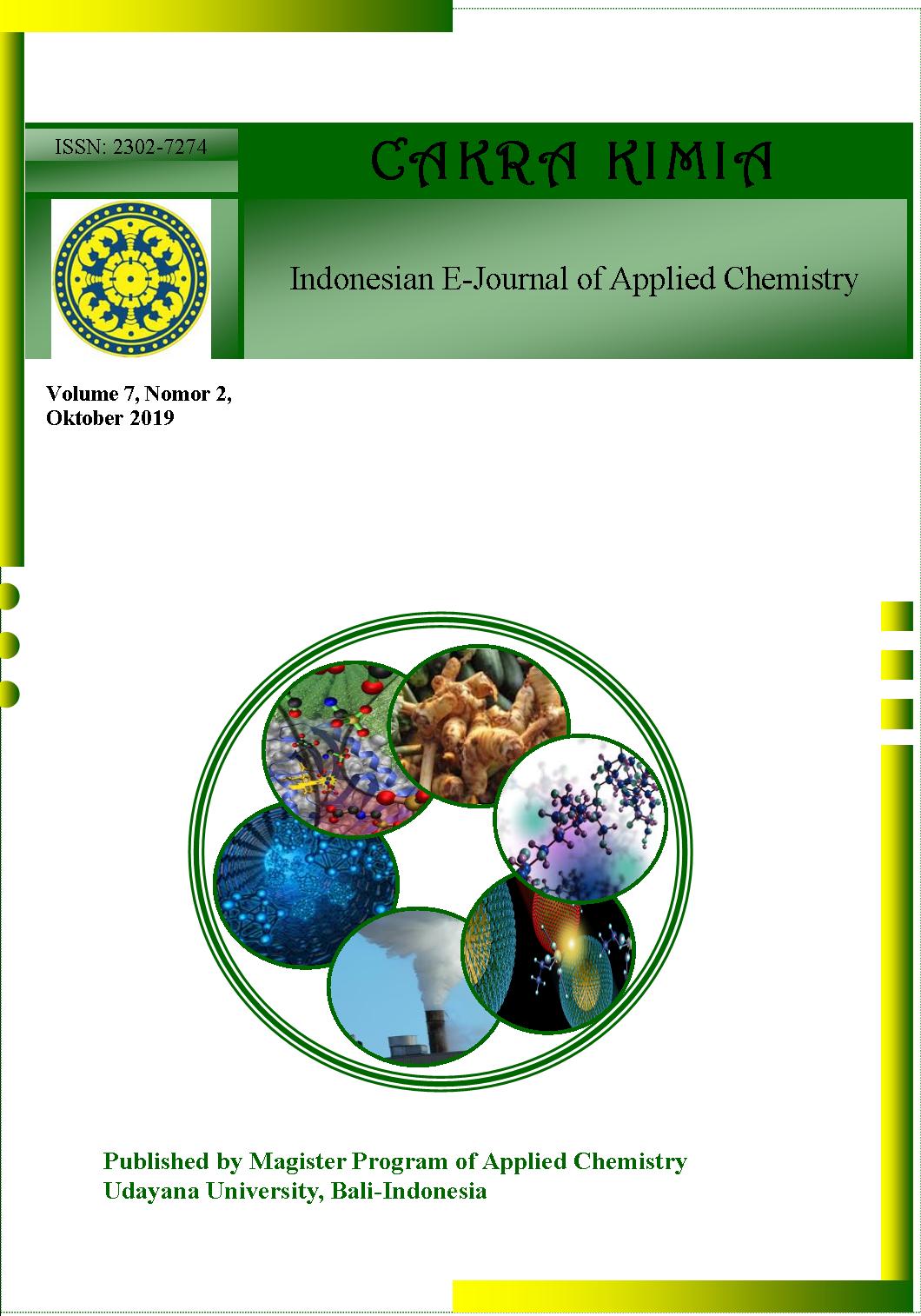KANDUNGAN Pb DAN Cr TOTAL DALAM AIR SERTA BIOAVAILABILITASNYA DALAM SEDIMEN DI PERAIRAN SUNGAI BEDADUNG JEMBER
Abstract
ABSTRAK: Sungai Bedadung yang membelah kota Jember memiliki resiko terhadap pencemaran karena sungai ini digunakan sebagai tempat pembuangan sampah. Penelitian ini bertujuan untuk menentukan tingkat pencemaran dan bioavailabilitas Pb dan Cr dalam sedimen di perairan sungai Bedadung Jember. Digesti sampel dilakukan menggunakan campuran HNO3 dan HCl (3:1) dalam ultrasonic bath pada suhu 60 oC selama 45 menit dilanjutkan dengan pemanasan pada suhu 140oC selama 45 menit. Spesiasi dilakukan dengan metode ekstraksi bertahap. Konsentrasi Pb dan Cr dianalisis menggunakan Atomic Absorption Spectrofotometer (AAS) dengan metode adisi standar tunggal untuk sampel air dan kurva kalibrasi untuk sampel sedimen. Hasil penelitian menunjukkan bahwa konsentrasi Pb dan Cr total dalam air berturut-turut sebesar 0,1103 - 0,6151 mg/L dan 0,0287 – 0,1731 mg/L, sedangkan konsentrasi Pb dan Cr total dalam sedimen berturut-turut sebesar 1,7075 – 10,6026 mg/kg dan 2,5256 – 8,0493 mg/kg. Hasil spesiasi logam Pb dan Cr berturut-turut adalah sebagai berikut: fraksi EFLE sebesar td (tidak terdeteksi) hingga 6,5456 mg/kg dan 0,8662 – 3,2820 mg/kg, fraksi Fe/Mn oksida sebesar td hingga 2,6743 mg/kg dan 0,3528 – 2,8290 mg/kg, fraksi organik sulfida sebesar 0,3541 – 3,2564 mg/kg dan 0,2197 – 1,2285 mg/kg serta fraksi Resistant sebesar td hingga 3,8375 mg/kg dan 0,1111 – 0,5943 mg/kg. Dengan demikian, dapat diketahui bahwa logam Pb dan Cr yang bioavailable sebesar td hingga 61,74% dan 34,30 – 59,71%, yang berpotensi bioavailable untuk logam Pb sebesar td hingga 49,69% dan 9,77 – 35,15% untuk logam Cr, sedangkan logam Pb dan Cr yang non-bioavailable sebesar td hingga 58,68% dan 3,08 – 22,34%.
Kata kunci: bioavailabilitas, Cr, Pb, sungai Bedadung Jember
ABSTRACT: Bedadung River dividing the city of Jember faces the risk of pollution because of the fact that this river has become a waste disposal area. This study aimed to determine the level of pollution and bioavailability of Pb and Cr in sediments of the Bedadung Jember river. The sample digestion was carried out using the mixture of HNO3 and HCl (3:1) in an ultrasonic bath at 60 oC for 45 minutes followed by heating at 140 oC for 45 minutes. The speciation was carried out by four stages sequential extraction method. Pb and Cr concentrations in the solution were analyzed by using Atomic Absorption Spectrophotometer (AAS) with a single standard addition method for water samples and calibration curves for sediment. The results showed that the total Pb and Cr concentrations in the water were 0.1103 – 0.6151 mg/L and 0.0287 – 0.1731 mg/L, respectively, while the total Pb and Cr concentrations in the sediments were 1.7075 – 10.6026 mg/kg and 2.5256 – 8.0493 mg/kg, respectively. The results of the speciation for Pb and Cr metals were as follows: EFLE fraction of nd (undetectable) – 6.5456 mg/kg and 0.8662 – 3.2820 mg/kg, Fe/Mn oxide fraction of nd – 2.6743 mg/kg and 0.3528 – 2.8290 mg/kg, organic sulfide fraction of 0.3541 – 3.2564 mg/kg and 0.2197 – 1.2285 mg/kg and resistant fraction of nd – 3.8375 mg/kg and 0.1111 – 0.5943 mg/kg, respectively. From these results, it could be found that the bioavailable, potentially bioavailable and non-bioavailable of Pb and Cr were nd – 61.74% and 34.30 – 59.71%, nd – 49.69% and 9.77 – 35.15%; and nd – 58.68% and 3.08 – 22.34%, respectively.
Downloads
References
[2] Harahap, S. 1991. Tingkat Pencemaran Air Kali Cakung Ditinjau dari Sifat Fisika-Kimia Khususnya Logam Berat dan Keanekaragaman Jenis Hewan Benthos Makro. Bogor: IPB. 167.
[3] Munandar, K., dan Eurika N. 2016. Keanekaragaman Ikan yang Bernilai Ekonomi dan Kandungan Logam Berat Pb dan Cd pada Ikan Sapu-Sapu Di Sungai Bedadung Jember. Proceeding Biology Education Conference: Seminar Nasional XIII Pendidikan Biologi FKIP UNS. 13(1): 717-722.
[4] Ginanjar, R., Munandar, K., dan Hapsari, A. I. 2016. Kadar Logam Berat Pb dan Cd Pada Ikan Nila (Oreochromis nilotica) Di Sungai Bedadung Wilayah Kota Jember. Skripsi. Pendidikan Biologi Fkip-Universitas Muhammadiyah Jember. Jember.
[5] Mauna, R. B., Ma’rufi, I., dan Nigrum, P. T. 2015. Kandungan Kromium (Cr) pada Limbah Cair dan Air Sungai serta Keluhan Kesehatan Masyarakat di Sekitar Industri Elektroplating (Studi di Industri Elektroplating X Kelurahan Tegal Besar Kecamatan Kaliwates Kabupaten Jember). Artikel Ilmiah Hasil Penelitian Mahasiswa. Universitas Jember. Jember.
[6] Siaka, M., Owens, C. M., and Birch, G. F. 2006. Evaluation of Some Digestion Methods for the Determination of Heavy Metals in Sediment Sample by Flame-AAS. Analytical Letters. 31(4): 703-718.
[7] Davidson, C. M., Duncan, A. L., Littlejohn, D., Ure, A. M., Garden, L. M. 1998. A Critical Evaluation of The Tree-Stage BCR Sequential Extraction Procedure to Assess The Potential Mobility and Toxicity of Heavy Metals in Industially-Contaminated Land. Analytica Chimica Acta. 393: 45-55.
[8] Australian and New Zealand Environment and Conservation Council (ANZECC). 2000. ANZECC Interim Sediment Quality Guidelines. Report for the Environmental Research Institute of the Supervising Scientist. Sydney. Australia: ANZECC ISQG-Low.
[9] Tessier, A., Campbell, P.G.C., and Bisson, M. 1979. Sequential Extraction Procedure for the Speciation of Particulate Tracemetals. Analytical Chemistry. 51: 844-851.
[10] Zaenal, A., Fadhlina, D. 2007. Geokimia Logam Berat Pb, Cd, Cu dan Zn dalam Sedimen di Perairan Teluk Jakarta. Bogor: IPB Press.
[11] Badri, M. A., and Aston, S. R. 1983. Observations in Heavy Metal Geochemical Associations in Polluted and Non-Polluted Estuarine Sediments. Environmental Pollution (Series B). 6: 181-193.



 Petunjuk Penulisan
Petunjuk Penulisan
